We’re passionate about no-code because it allows everyone to create apps and websites without code. We love that you no longer need to have extensive knowledge of programming to build a kick-ass project for your business or personal use. No code brings your idea to life and democratizes everyone’s ability to build products.
That said, it can be difficult to know which no-code tool to choose. That’s because there’s an abundance of no-code platforms out there, following the impressive rise in popularity of such solutions.
We’ve compiled a comprehensive guide to the most powerful no-code tools in existence. You can choose which works best for your use cases without the hassle of sifting through hundreds of reviews. But first, we’ll be talking about:
What is no code?
What are the benefits of no code?
Why is no code the future?
Let’s dive right in!
What is No Code? Everything You Need to Know
No code is both a worldwide movement that promotes citizen development, and a method of building apps and websites without code. This works by using GUI (Graphic User Interface) tools that display code as visual elements that you can drag and drop to your liking.
Even a few years back, you would have needed a team of software developers to create apps. With no code, it only takes placing things on an interface to build gorgeous and functional apps + websites.
No code tools vary in complexity – some will enable you to create simple one-page websites, while others provide impressively complete options for full-blown software (hi Bubble!). Some no-code platforms will even let you export your project in code so that you can leverage programming languages for different functionalities.
Regardless of which no-code platform you choose, you’ll be able to reap the rewards that come with building custom apps and websites for any use. Some common usages for no-code projects are:
Inventory software
Directories
CRMs (Client Relationship Management)
Delivery apps
Interactive guides
and more.
1. Best No Code Tool for Complex Web Apps: Bubble

Bubble is a no-code platform that you can use to design and develop software + websites without code. Bubble was founded in 2012, and currently has over 2 million registered users.
✅ Want to find out more about Bubble? Check out our full Bubble review!
The Benefits of Bubble.io
An interactive drag-and-drop interface and visual editor to build projects fast and efficiently
A built-in encrypted database that keeps your project secure
Easy-peasy deployment which allows you to publish your project at the click of a button
A workflow editor for you to build custom automation around your project
Impressive scalability so that you can build a whole range of projects, from simple web apps to complex software
Hundreds of plugins and APIs to leverage so that you can connect your project with other platforms like Calendly, Google Suite, and many more.
The Disadvantages of Bubble.io
You currently cannot create a native app with Bubble, which means you won’t be able to publish your app on the App Store or Google Play Store.
It can be more difficult to make beautiful Bubble apps, which is why people tend to hire no code developers or no code agencies for their Bubble projects.

What Can You Build With Bubble.io?
Custom marketplaces
Social media platforms
Inventory apps
Booking apps
Internal business tools
Delivery apps
Directory apps
✅ Want to see some projects that were built with Bubble? Check out our article about Bubble-built projects.
You can get tips on how to find a Bubble developer or reach out to our team of expert Bubble developers who can help bring your idea to life. Or if you want to build yourself, use the Bubble Buddy to help.
Bubble.io Pricing
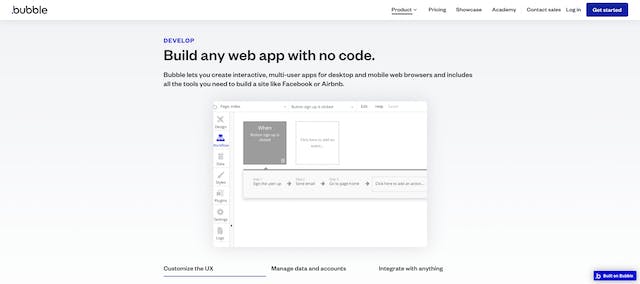
Free Personal Professional Production
Free $25 per month. $115per month $475per month
2. Best No Code Tool for Collaborative Design: Figma
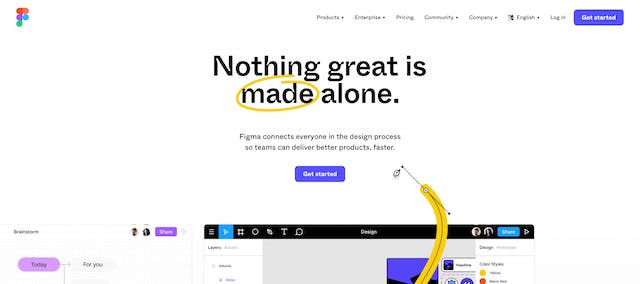
Figma is a no-code tool that will enable you to create designs, prototype, and collaborate with people by effortlessly gathering feedback in one place.
The Benefits of Figma
Figma is really fast to use. Everything is accessible via one platform
You can design pretty much anything with Figma – logos, websites, apps…
You can easily create animations with Figma
Figma has a truly active community of designers who’ll gladly help you navigate the platform
Figma is web-based so you can keep designing whichever computer you’re working from – we find this is particularly handy if you work in a hybrid setting!
Figma integrates with Slack for easy communication
The Disadvantages of Figma
Figma requires an internet connection to use. If you’re a commuter, you might not appreciate that you can’t work on designs without Wifi
Figma lacks version control. It’s difficult to see exactly what change was implemented when
You can’t search for text in Figma, which might cause some issues for you if your designs are text-heavy
What Can You Build With Figma?
Mindmaps
Comics
Storyboards
App prototypes
Website design
Email layouts
📣 Do be aware that Figma is only a design tool. You won’t be able to fully build anything with Figma. However, it offers extensive design functionalities that will allow you to prototype the projects that you can later build with no code platforms.
We have a team of expert Figma designers who can bring your idea to life.
Figma Pricing

Free Professional Organisation
Free forever £11 per editor/month £37 per editor/month

3. Best No Code Tool for Websites: Webflow
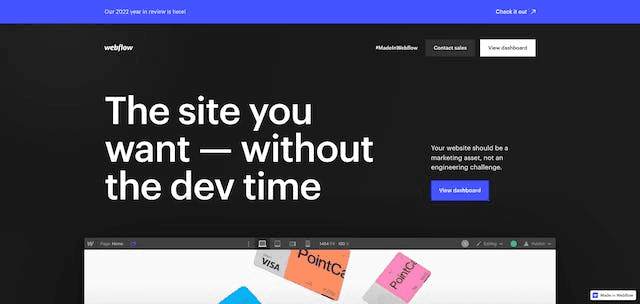
Webflow is an in-browser website design platform that allows you to prototype, build and publish fantastic websites without using code. Webflow’s visual editor translates HTML, CSS, and JavaScript into building blocks that you can easily assemble to your liking on the screen.
The Benefits of Webflow
Webflow offers complete customization options for your project, which means you can end up with a pretty unique website
Webflow has an amazing Content Management System (CMS) which will allow you to effortlessly create, publish and manage blog posts.
It’s really easy to combine website building and hosting with Webflow as it offers some neat paid hosting packages.
The Disadvantages of Webflow
Webflow lacks templates compared to some other platforms like Glide, so you might want to go with something else if you want a pre-built website
Webflow offers limited code customization, so what you see is what you get
Some users have difficulties in learning Webflow
What Can You Build With Webflow?
Website
Blogs
eCommerce stores
Gated content
Webflow Pricing

StarterBasic CMS Business
Free $14 per month $23 per month $39 per month
4. Best No Code Tool for Templates: Glide
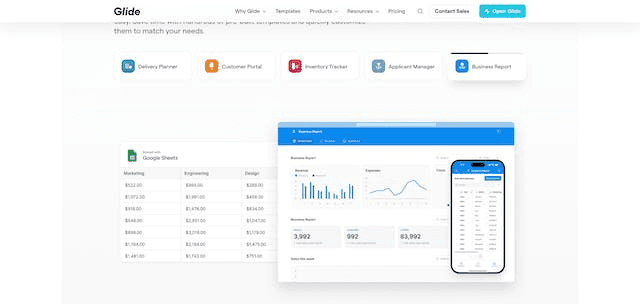
Glide is a no code visual editor for building apps, powered by spreadsheet data. Glide is known for its extensive template library which will enable you to literally build a simple app in minutes.
The Benefits of Glide
Glide is free at first so you can build your project without having to pay until you publish (for up to 500 rows of data)
Glide has a pretty pleasant interface which allows for easy collaboration
Glide has lots of templates so you can build an app really fast without having to build anything from scratch
The Disadvantages of Glide
There isn’t much flexibility on Glide, which means you might not be able to customize your apps as much as you’d like
You can’t publish your Glide app on the App Store or Google Play store
You won’t be able to use in-app notifications with Glide
Glide is slightly more expensive than some other platforms
What Can You Build With Glide?
Employee directory
Inventory software
CRM
E-commerce store
Food delivery app
Restaurant app
Job Board
And more.
⚡️ You can check out a full list of Glide’s templates in their template directory.
Glide Pricing

Starter Starter Pro Business Enterprise
Free $25 per $99 per $249 per $799 per
month month month month

5. Best No Code Tool for Websites from Spreadsheets: Softr
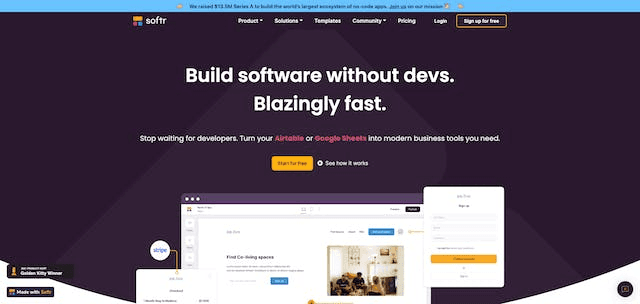
Softr is a web development platform that uses Airtable data to create websites impressively fast. Users can plug in their Airtable spreadsheets and with a few clicks, they get simple websites that they can then customize.
The Benefits of Softr
You won’t need plugins with Softr as opposed to WordPress for example
Softr is really fast to learn
Softr has some pretty advanced user authentication options for different people to be able to access different things on your website
The Disadvantages of Softr
Users have reported Softr being too expensive for what is is
Softr isn’t as powerful as other platforms like Bubble
What Can You Build With Softr?
Websites
Internal tools
Marketplaces
Directories
Softr Pricing
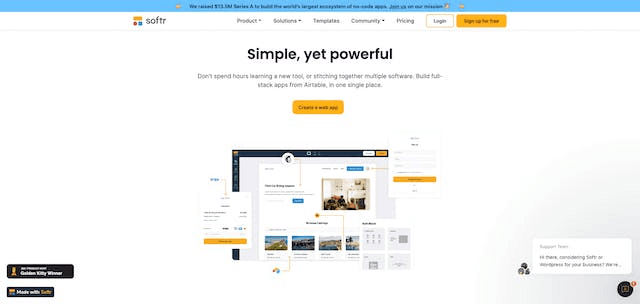
FreeStarter Professional Business
Free $24 per month $65 per month $165 per month
6. Best No Code Tool for Native Apps: Adalo
Adalo is a no-code tool that will allow you to create native apps, which are apps that can be used without an internet connection. That means that you can publish your project to Android and iOS devices.
The Benefits of Adalo
Adalo users have reported the platform is relatively easy to use
You can publish your app on the App Store or Google Play store
There is a free plan available with some limitations
The Disadvantages of Adalo
Adalo has limited features. For example, you can’t create custom actions like you can with Bubble
There aren’t many integrations available on Adalo
Adalo’s basic plan is more expensive than most other platforms’ basic plans
What Can You Build With Adalo?
Native apps
Web apps
Adalo Pricing
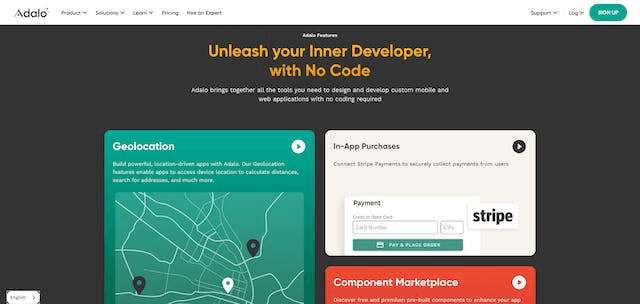
FreeStarter Professional Team Business
Free$45 per month$65 per month$200 per month$250 per month

7. Best No Code Tool for Storing Data: Airtable
Airtable is a web-based platform for building databases as alternatives to spreadsheets. Airtable’s interactive user interface allows users to create powerful databases in minutes which can have a myriad of different usages, whether business or personal.
The Benefits of Airtable
Airtable allows users to add, edit and manage real-time data
You can quickly change different views, which means you can have several different ways of accessing your data in the click of a button with Airtable
Airtable offers different integration and plugins options which can come in handy
The Disadvantages of Airtable
Airtable users have reported slow load times
Airtable is expensive for large teams and enterprises
It can be difficult to embed media with Airtable
What Can You Build With Airtable?
Relational databases
Airtable Pricing

FreePlus Pro
Free$10 per month $20 per month
The Best Tool to Effortlessly Build Apps Without Code Is…
We’ve reached a verdict on which is the best tool to build apps without code. It’s a tricky one, because all these different platforms serve varying purposes, whether it’s:
Building websites (Webflow)
Building web apps (Bubble)
Building databases (Airtable)
Building websites from spreadsheets (Softr)
Building websites from templates (Glide)
Drumroll, please… The best no-code tool to build apps in 2023 is Bubble!
We think that Bubble just has it all. The community, the ability to create complex projects, the integrations, and APIs, the intuitive user interface, the templates…
We reckon Bubble.io is so powerful here at Goodspeed that we build Bubble apps and websites for people all over the world. We can even help you build yours! 📞 Book a call with us so that we can get the ball rolling. You can also check out our no-code tool directory if you want to explore more platforms!
FAQ - Frequently Asked Questions
What are the benefits of no-code?
No code provides several benefits, including:
Speed: It enables developers to build and launch applications quickly without writing complex lines of code.
Accessibility: No-code platforms make it easier for people with little or no coding experience to build and launch applications.
Cost-effectiveness: No code development can save time and money by reducing the need for expensive software developers and speeding up the development process.
Scalability: No code platforms can scale apps to meet growing demand without requiring significant development resources.
Collaboration: No code platforms provide collaboration features that enable teams to work together on projects and improve communication.
Customization: No code apps can be customized to fit specific business needs without requiring extensive technical knowledge.
How no-code platforms can bring AI to small and midsize businesses?
No-code platforms make it easy for businesses to integrate AI technologies into their existing workflows without needing extensive technical knowledge. No-code AI solutions are typically less expensive than traditional AI development projects, making them accessible to small and midsize businesses.
AI technologies can be integrated into no-code platforms to provide businesses with the ability to personalize their customer experience and improve engagement. No-code platforms can also automate repetitive tasks and processes, freeing up valuable time and resources for businesses to focus on growth and innovation.
What can no code do?
No-code platforms can be used to create a wide range of apps, websites, and tools including:
Websites: Build custom websites, landing pages, and portfolios
Mobile Apps: Develop mobile apps for iOS and Android platforms
Workflows: Automate business processes and workflows
Database Management: Create, manage, and store data in custom databases
E-commerce Platforms: Build and manage online stores and marketplaces
Chatbots: Develop chatbots for customer service and support
Forms and Surveys: Create custom forms, surveys, and questionnaires
Marketing Campaigns: Develop and launch marketing campaigns, including email and social media
Dashboards: Create interactive dashboards to monitor key metrics

What are 3 examples of no-code tools?
Here are three popular no-code tools:
Bubble: A visual programming platform that allows users to build web and mobile applications without writing code.
Webflow: A web design and development platform that allows users to create custom websites and digital experiences.
Airtable: A cloud-based platform that combines the functionality of a database and a spreadsheet to help users manage and organize data. It provides a visual interface for creating and managing tables, forms, and relationships, and can be used for a wide range of purposes, from project management to event planning.
Frequently Asked Questions (FAQs)
1. What is "no code" and how does it work?
"No code" refers to a movement and method that enables individuals to create apps and websites without requiring coding skills. It utilizes Graphic User Interface (GUI) tools where code is presented visually as elements that can be dragged and dropped. Instead of writing code, users manipulate visual components to build functional apps and websites, democratizing the process of creating digital products.
2. What are the advantages of using no-code tools?
No-code tools offer several benefits, including:
Speed: Rapidly develop applications without extensive coding.
Accessibility: Enable non-developers to participate in creating digital projects.
Cost-effectiveness: Reduce the need for skilled developers, saving time and money.
Scalability: Easily scale projects to meet growing demands.
Collaboration: Facilitate teamwork and communication on projects.
Customization: Tailor apps and websites to specific business needs.
3. How can no-code platforms incorporate AI into businesses? No-code platforms make AI integration accessible for small and midsize businesses. They allow businesses to incorporate AI technologies into workflows without requiring extensive technical expertise. This integration can personalize customer experiences, automate tasks, and improve engagement. No-code AI solutions are typically more cost-effective compared to traditional AI development, making AI adoption feasible for a broader range of businesses.
4. What types of projects can be created using no-code platforms?
No-code platforms enable the creation of various digital projects, including:
Websites: Develop customized websites, landing pages, and portfolios.
Mobile Apps: Build applications for iOS and Android platforms.
Workflows: Automate business processes and tasks.
Database Management: Create, manage, and store data in databases.
E-commerce Platforms: Establish online stores and marketplaces.
Chatbots: Develop interactive chatbots for customer service.
Forms and Surveys: Create customizable forms and surveys.
Marketing Campaigns: Design and launch marketing campaigns.
Dashboards: Build interactive dashboards for monitoring metrics.
5. What are some examples of powerful no-code tools available? Several powerful no-code tools include:
: A platform for building web and mobile apps without coding, offering scalability and integration options.
Webflow: A web design and development platform for creating custom websites and digital experiences.
Airtable: A cloud-based platform combining database and spreadsheet functionalities for data organization.
Glide: A visual editor for building apps using spreadsheet data, known for its template library.
Softr: A platform that uses Airtable data to create websites quickly, offering simplicity and customization.
You Might Like

Conclusion
Harish Malhi
Founder of Goodspeed
Harish Malhi is the founder of Goodspeed, one of the top-rated Bubble agencies globally and winner of Bubble’s Agency of the Year award in 2024. He left Google to launch his first app, Diaspo, built entirely on Bubble, which gained press coverage from the BBC, ITV and more. Since then, he has helped ship over 200 products using Bubble, Framer, n8n and more - from internal tools to full-scale SaaS platforms. Harish now leads a team that helps founders and operators replace clunky workflows with fast, flexible software without writing a line of code.
Frequently Asked Questions (FAQs)
What is no-code and how does it work?
No-code is both a worldwide movement that promotes citizen development and a method of building apps and websites without writing code. It works by using GUI (Graphic User Interface) tools that display code as visual elements you can drag and drop to your liking, allowing anyone to create functional apps and websites without programming knowledge.
What are the main benefits of using no-code platforms?
No-code platforms offer several key benefits including speed (rapid development without complex coding), accessibility (enables non-developers to build applications), cost-effectiveness (reduces need for expensive developers), scalability (can grow with demand), improved collaboration (teams can work together easily), and customization (apps can be tailored to specific business needs without technical knowledge).
Which no-code tool is best for building complex web applications?
Bubble is the best no-code tool for building complex web applications. It offers an interactive drag-and-drop interface, built-in encrypted database, easy deployment, workflow editor for custom automation, impressive scalability, and hundreds of plugins and APIs. With over 2 million registered users, Bubble can handle projects ranging from simple web apps to complex software.
What types of projects can be built using no-code platforms?
No-code platforms can be used to create a wide variety of projects including websites, mobile apps, social media platforms, marketplaces, CRMs, MVPs, delivery apps, inventory software, e-commerce stores, chatbots, job boards, directories, automated workflows, forms and surveys, marketing campaigns, and interactive dashboards.
How can no-code platforms bring AI capabilities to small and midsize businesses?
No-code platforms make it easy for businesses to integrate AI technologies into their existing workflows without extensive technical knowledge. These AI solutions are typically less expensive than traditional AI development projects, making them accessible to smaller businesses. They can automate repetitive tasks, personalize customer experiences, improve engagement, and free up valuable time and resources for growth and innovation.
What is the difference between Bubble and Adalo for app development?
The main difference is that Bubble specializes in complex web applications with extensive customization and scalability, while Adalo focuses on native apps that can be published to the App Store and Google Play Store. However, Bubble offers more features like custom actions and integrations, whereas Adalo has limited features and fewer integrations but allows offline app usage.
What are the limitations of using Webflow for website development?
Webflow has several limitations including fewer templates compared to platforms like Glide, limited code customization options (what you see is what you get), and some users find it difficult to learn. While it offers complete customization for websites and an excellent CMS for blogs, it's primarily focused on website building rather than complex app functionality.









